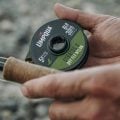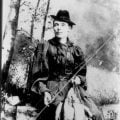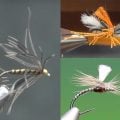How to Tie a Woolly Bugger Euro Jig
Producer: Tim Flagler
The Woolly Bugger Euro Jig is pretty much a standard Woolly Bugger, only it’s tied on a long-shanked jig hook and incorporates a slotted tungsten bead. So, in addition to all the merits of a Woolly Bugger, it will ride, generally, hook point up thus avoiding snags. It will also move with an enticing jiggy motion.
For a hook, I’m going to go with a 2X long Fulling Mill 5130 in size 10. The hook pairs well with a 5/32” black nickel slotted tungsten bead. Insert the point of the hook into the small hole of the bead and work the bead around up the shank to behind the eye. Then get the whole assembly firmly secured in the jaws of your tying vise. The square end of the slot on the bead should be pointed down.
For thread, I load a bobbin with a spool of light olive 140 Denier. You can drop down to 70 Denier for smaller versions of this pattern. Get the thread started on the hook shank behind the bead and after a few wraps, snip off the excess tag. Wrap back up to immediately behind the bead.
.02 lead-free round wire is used to add even more weight to the fly and to stabilize the bead. While holding the spool, insert the end of the wire into the slot of the bead on top of the hook shank. Take a few wraps of tying thread right there to anchor the bitter end of the wire. Start taking rearward wraps with the wire behind your tying thread. Pushing up on the thread as you go will help to keep the wire wraps sandwiched close together. After 8 or so wraps with the wire, take thread wraps over top of it then pull the wire back, on top of the hook shank, and take thread wraps to bind it down there. Wiggle the wire as you wrap to break it off and leave a ramp down to the hook shank.
Olive Woolly Bugger marabou is used for the tail of the fly. Find the point on the feather where the stem begins to noticeably thin and snip it there. I’m going to use the top of the feather for this fly but don’t discard the bottom, as its fibers can be used elsewhere. Wet the feather’s tip, which will make it far more manageable during tie-in. Measure to form a tail a full hook in length then transfer that measurement rearward to the start of the bend. Using the back edge of the wire wraps as a guide, snip the butt end of the feather off square. Give your bobbin a counterclockwise spin, as if you’re looking down on it. This will cause the first thread wrap to jump rearward and catch the butt ends of the marabou. Continue taking thread wraps rearward to firmly bind the marabou to the top of the hook shank, all the way back to the start of the bend. Advance your tying thread forward to the back edge of the wire wraps.
For a little bit of flash, snip 3 strands of root beer Krystal Flash free from the hank and find their midpoint. Place the midpoint against the near side of the hook at the location of your tying thread and take a few wraps to secure it. Continue binding it to the near side of the hook back to the bend. Now pull the forward-pointing portion of the Krystal Flash back and anchor it on the far side of the hook. Wrap first up the shank then back down to further secure the flash. End with your tying thread at the base of the tail. Snip the flash off even with the tip of the tail.
Medium-sized olive Antron chenille is used to form the body of the fly. An 8” length is enough to make a few flies. Strip the fuzzy stuff from one end of the chenille to expose the string core. Lay the core against the near side of the hook, at the location of your tying thread, then take wraps to secure it. Make sure it’s bound down really well. End with your thread at the midpoint of the hook shank.
A light olive grizzly hackle feather is used to hackle the fly. This one’s nice and long, and its lower fibers are about a hook gap in length, just perfect. Strip the lower fuzzy fibers free from the stem then, with the dull side of the feather facing you and the tip pointing to the front of the fly, lay the stem against the near side of the hook. You want the fibers to start right at the back edge of the bead. Take tight wraps of tying thread to anchor the stem there. End with your thread at the bead. You can then lift the excess stem up and snip it off close.
Get hold of the chenille and start making touching wraps with it up the hook shank. When you reach the bead, anchor the chenille with tight wraps of tying thread and snip the excess off close. This time, give your bobbin a healthy clockwise spin to cord up, strengthen and thin your tying thread. Make open spiral wraps with the thread over top of the chenille. These are cross wraps which will add to the fly’s durability. End with a few thread wraps right at the base of the tail.
Take at least two wraps, one directly behind the other, up by the head before making open spiral wraps down the body of the fly. When you reach your tying thread, use it to anchor the tip of the hackle feather. If you’re brave, you can break this tip off but it’s generally safer to simply reach in with the very tips of your tying scissors and snip it off close.
Now, once again, give your bobbin a clockwise spin to cord up the thread. Start making open spiral wraps, kind of weaving your way through the hackle so as not to trap fibers. Here, you’re doing cross wrapping over the hackle stem, once again increasing fly durability. End with your tying thread at the back edge of the bead. Reach for your whip finish tool and use it to do a 5 or 6 turn whip finish, seat the knot well and snip or cut your tying thread free. If you’ve trapped any fibers during the whip finish process, just snip them off close, no one will be the wiser.
It’s kind of important with this fly to apply an ample drop of head cement to the thread wraps. Once it sinks in and dries, there’s little chance of them coming unraveled.
And that’s the olive Woolly Bugger Euro Jig. Make sure you always have a bunch in brown and black as well.
How to Tie a Wood Duck Scud
How to Tie a Woolly Worm











